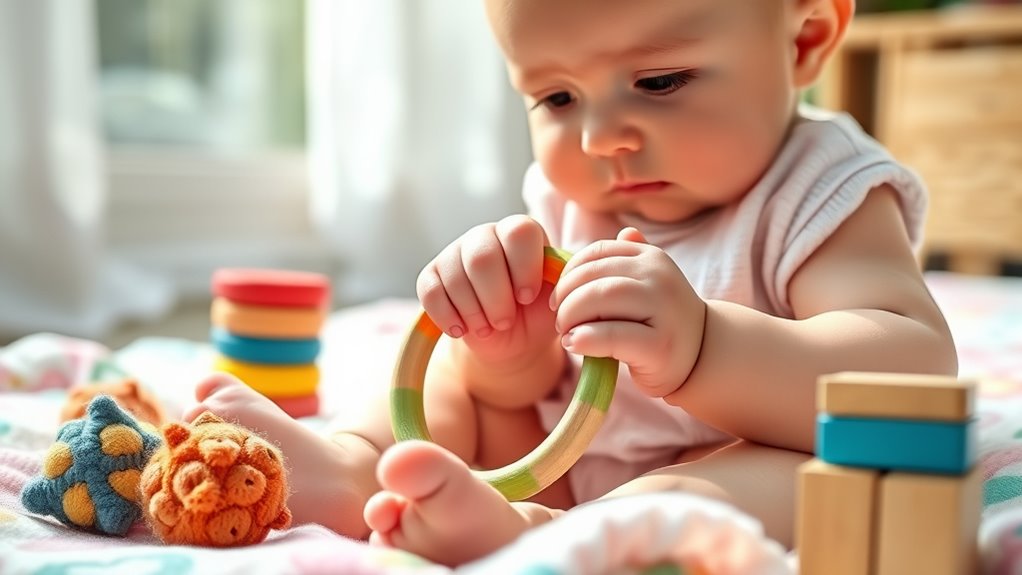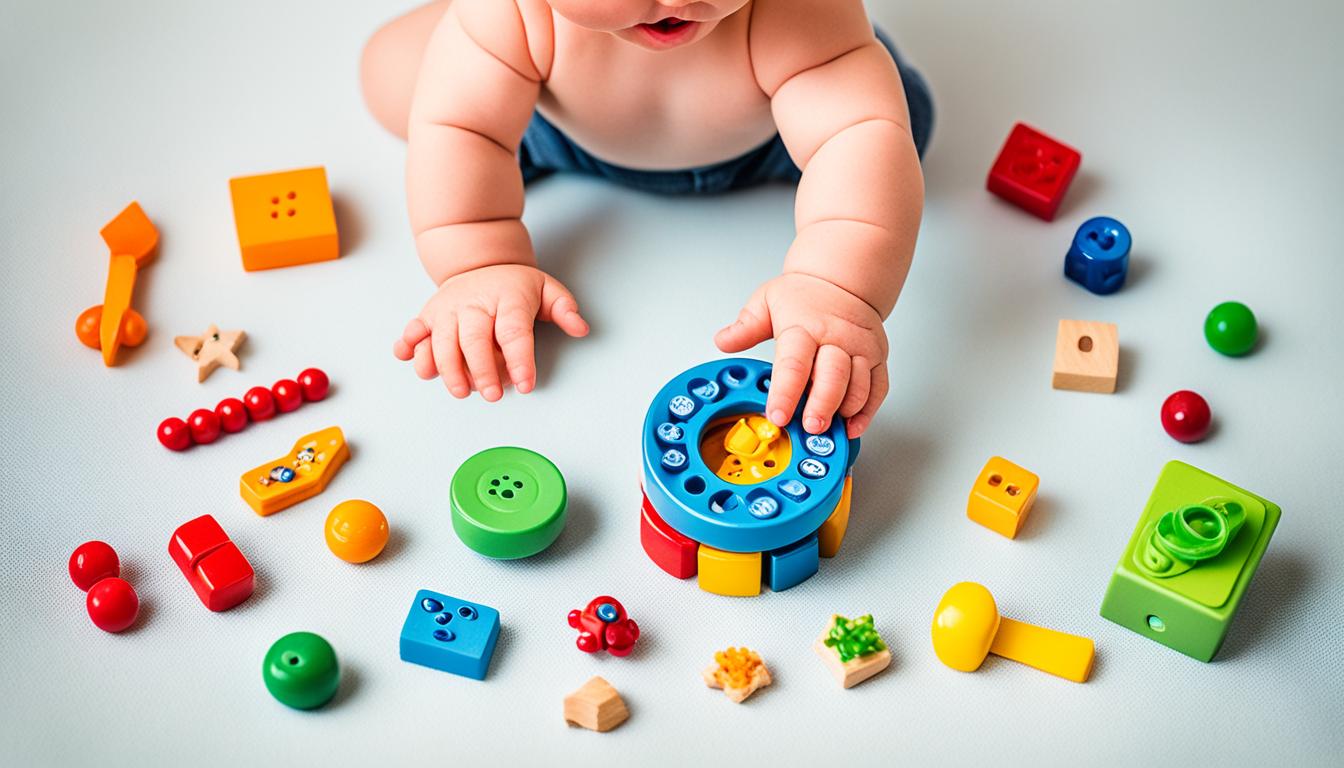To help your 6–12 month-old develop hand skills, engage them in safe activities like tactile play with textured toys and soft books that encourage grasping and exploring. Offer finger foods to practice pincer grip and use household items for safe grasping fun. Water play and reach-and-grab games boost coordination, while sorting games teach categorization. Keep objects safe and supervise play to make each activity a fun, skill-building adventure—continue exploring these tips for more ideas.
Key Takeaways
- Engage babies in tactile play with textured toys and soft books to strengthen hand muscles and enhance sensory discrimination.
- Encourage self-feeding with colorful finger foods to develop pincer grip and fine motor control.
- Use safe household items like cups and utensils to promote grasping, coordination, and safe exploration.
- Incorporate water play and splash activities to improve hand-eye coordination and finger strength through pouring and splashing.
- Include sorting and reach-and-grab games to foster object recognition, categorization, and visual-motor skills.
Tactile Play With Textured Toys
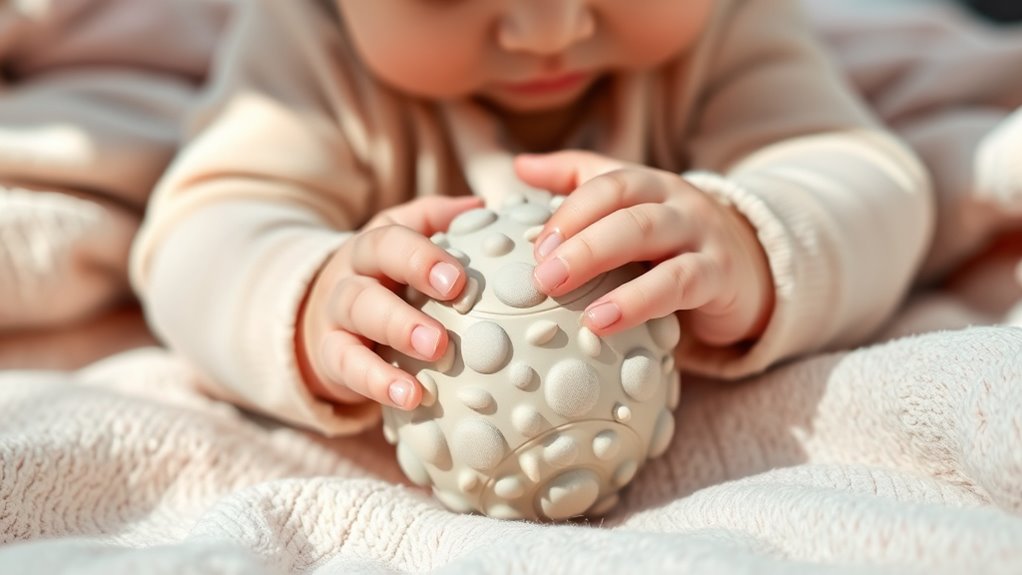
Tactile play with textured toys helps babies develop their sense of touch and fine motor skills. When you introduce toys with different textures, you’re encouraging sensory exploration. Your baby will feel the rough, smooth, bumpy, or soft surfaces, which helps improve texture discrimination. As they grasp and manipulate these toys, they strengthen their hand muscles and coordination. This type of play also sparks curiosity and engages their senses, laying a foundation for more complex motor activities later. Keep toys varied and safe, offering a range of textures to explore. By doing so, you’re supporting their sensory development and helping them become more confident in handling different objects. Additionally, incorporating high-quality projectors in their environment can create engaging visual stimuli that further stimulate their visual senses. Engaging in sensory-rich activities like tactile play is a simple, effective way to nurture your baby’s growing fine motor skills. Incorporating Montessori principles can enhance the educational value of these activities, fostering independence and exploration. Introducing a variety of textured materials also encourages texture discrimination, an important aspect of sensory development. Studies show that multisensory experiences can significantly enhance neural pathways related to sensory processing and motor skills, making this approach especially beneficial for early development.
Finger Foods for Pincer Grip Practice
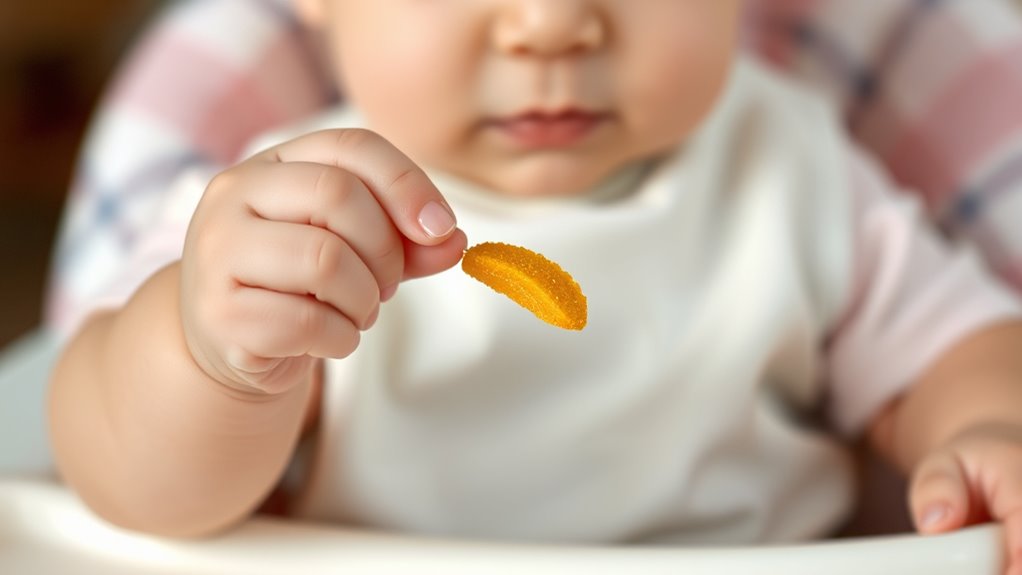
Offering colorful snack options can make pincer grip practice more engaging for your baby. Try choosing textured foods like soft fruits and crunchy vegetables to help develop their fine motor skills. These choices encourage grasping and improve hand-eye coordination effortlessly. Incorporating fine motor development can further support safe and successful self-feeding experiences. Additionally, introducing foods with different shapes and sizes can enhance hand strength and dexterity, making eating a more dynamic activity.
Colorful Snack Options
Introducing colorful snack options is a fun and effective way to help your baby practice the pincer grip. Offering healthy snack ideas like small pieces of colorful fruit options encourages precise finger movements. Choose bright, soft fruits such as blueberries, sliced strawberries, or mango chunks that are easy for your baby to grasp and pick up. These vibrant foods not only stimulate visual development but also make snack time engaging. As your little one reaches for and pinches the pieces, they strengthen fine motor skills and hand-eye coordination. Keep the pieces small and manageable, ensuring safety while promoting independence. Incorporating colorful fruit options into snack time makes practicing the pincer grip enjoyable and nutritious, supporting your baby’s overall development. Additionally, understanding safe tanning practices can help you protect your skin as you explore outdoor activities with your little one. Engaging in fine motor activities like these can also support overall hand development and coordination, especially when combined with proper storage of oils to maintain safety and efficacy.
Textured Food Choices
Building on the idea of colorful snack options, incorporating textured foods can further enhance your baby’s pincer grip practice. Offering a variety of flavorful puree options alongside finger-friendly textures encourages exploration. Presenting foods in appealing textured food presentation helps your baby develop hand-eye coordination and grip strength. Try small, soft pieces like cooked vegetables, ripe fruit, or cheese. Use the table below to inspire your selection:
| Food Type | Texture | Example |
|---|---|---|
| Vegetables | Soft, cooked | Carrot sticks, green beans |
| Fruits | Ripe, easy to grasp | Banana slices, berries |
| Dairy | Soft, manageable | Cheese cubes |
| Grains | Slightly firm, small pieces | Toast strips, rice cakes |
| Flavorful Purees | Thick, spoonable | Sweet potato, apple sauce |
This approach promotes fine motor skill development through engaging, textured food presentation. Incorporating appropriate textures is essential for safe and effective pincer grip practice.
Water Play and Splashing Activities
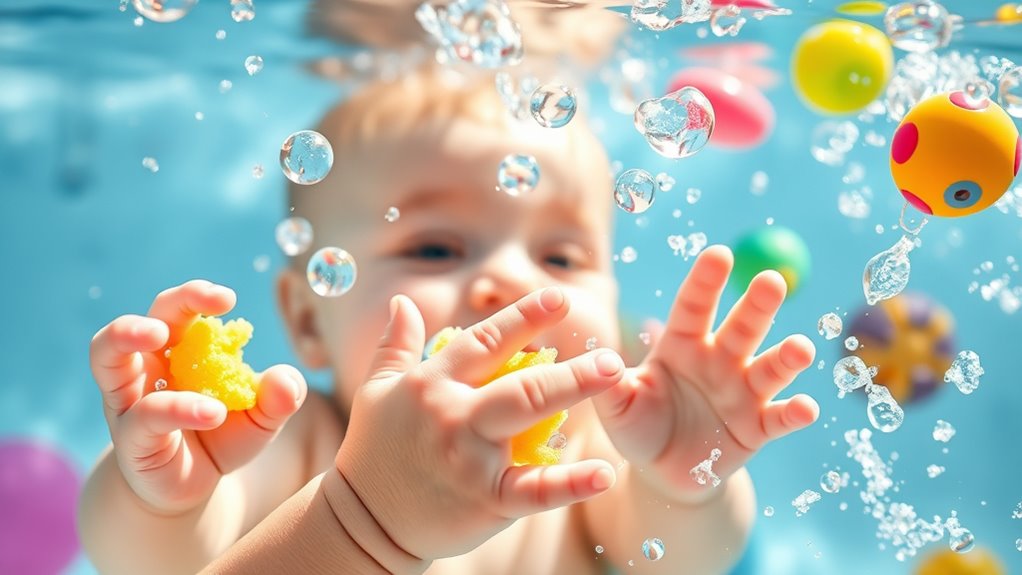
Water play and splashing activities provide excellent opportunities for your baby to develop fine motor skills while having fun. When your baby engages in water splashing, they strengthen their hand muscles and improve coordination. Pouring activities are especially beneficial, as they encourage grasping, transferring, and controlled movements. Use small cups or bowls to help your little one practice pouring water from one container to another, fostering precision and hand-eye coordination. As they splash and pour, they refine their pincer grasp and finger strength. Incorporating sensory exploration into water activities further enhances their learning experience. Keep the environment safe and supervise closely to prevent slips or choking hazards. These activities not only boost your baby’s hand skills but also introduce them to sensory exploration and cause-and-effect relationships, making water play both enjoyable and educational. Engaging in early motor skill development through water activities supports their overall physical growth and coordination.
Simple Picking and Sorting Games
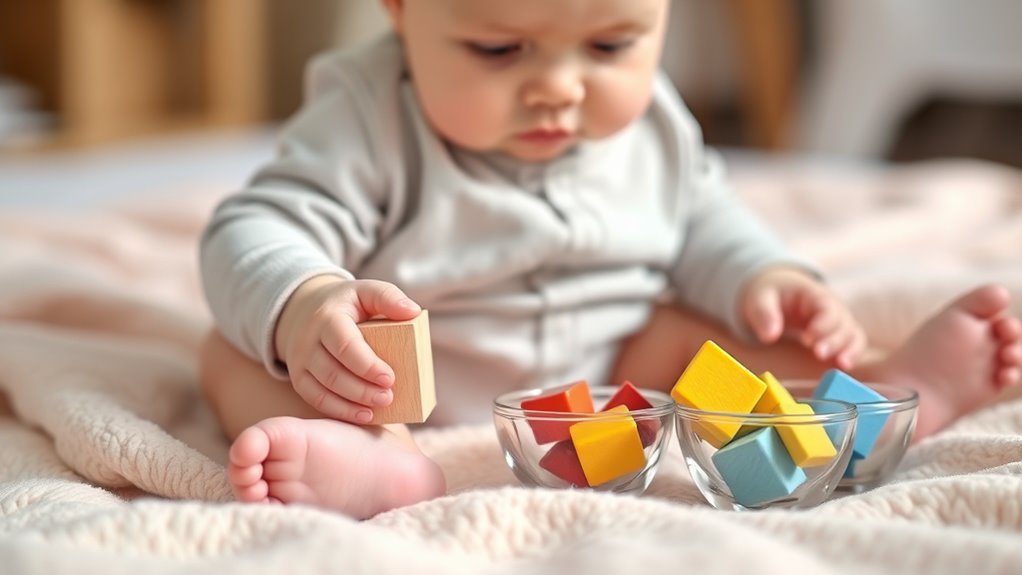
Have you ever thought about how simple picking and sorting games can boost your baby’s fine motor skills? These activities encourage your little one to practice grasping, hand-eye coordination, and object recognition. By engaging in color sorting and object matching, they learn to differentiate and categorize items, strengthening their visual and tactile skills. You can set up easy games like sorting colorful blocks or matching small toys to matching containers. These activities are fun and promote independence while refining fine motor control. Plus, they help your baby develop concentration and problem-solving skills. Incorporating on-device AI capabilities into educational toys can further personalize and enhance your child’s learning experience. Incorporate a variety of textures and colors to keep your baby engaged and motivated. Simple picking and sorting games are a practical and effective way to support your baby’s hand development during this critical age.
Using Safe Household Items for Grasping

You can encourage your baby’s grasping skills by choosing safe household items that are easy to hold. Make sure the objects are sturdy, non-toxic, and free of sharp edges. Always supervise play to keep your little one safe and help them explore confidently. Using age-appropriate toys can further enhance their hand-eye coordination and fine motor development. Incorporating household items that promote payment security can also teach your child about safe handling of objects. Additionally, selecting items that are vetting standards ensures they are safe and suitable for your baby’s developmental stage. Understanding self watering plant pots can inspire you to choose items that are durable and stable, supporting safe grasping practice.
Safe Materials Selection
Choosing safe household items for your baby’s grasping activities is essential to guarantee their safety and promote healthy development. Focus on materials that are free from harmful chemicals and gentle on their skin. Look for items made with hypoallergenic fabrics and avoid anything with sharp edges or small parts that could pose a choking hazard. When selecting objects, ensure they’re easy to clean and free from toxins, like non toxic paints or dyes. Soft, smooth textures encourage exploration without irritation. Remember, safety first—always inspect items for durability and stability. Using household items thoughtfully helps build your baby’s hand skills while keeping them safe during playtime. Incorporating developmentally appropriate safety measures ensures a secure environment for your little one’s development. Choose toys made from safe materials such as soft silicone or rubber, which are designed for gentle mouthing and grasping.
Easy-to-Grasp Items
Selecting easy-to-grasp household items encourages your baby to develop their hand muscles and coordination. Items like sensory bags filled with textured materials or lightweight musical instruments, such as shakers or small drums, are perfect choices. Sensory bags offer tactile stimulation, helping your baby improve grip strength and explore different textures safely. Musical instruments encourage grasping and shaking, boosting hand-eye coordination and fine motor control. Make sure all items are free of small parts or sharp edges. You can even repurpose household objects, like plastic containers or wooden spoons, as long as they’re safe and easy for your baby to hold. These simple, familiar items make practice engaging and help build essential hand skills during this vital developmental stage.
Supervised Play Tips
Supervised play with household items helps your baby practice grasping safely and effectively. When choosing items, guarantee they are age appropriate toys that match your baby’s developmental stage. Always follow safety precautions by inspecting objects for sharp edges, small parts, or choking hazards. Keep an eye on your little one, and never leave them unattended during play. Use household items like soft sponges, plastic cups, or silicone utensils that are sturdy and safe for grasping. Avoid items with loose parts or toxic materials. Creating a safe environment allows your baby to explore and develop hand skills confidently. Remember, supervision and careful selection of household items are key to a fun and safe grasping practice.
Exploring With Soft and Crinkly Books

Soft and crinkly books are wonderful tools for encouraging your baby’s exploration and developing their fine motor skills. These books promote sensory exploration by engaging your baby’s sense of touch, sound, and sight. As they grasp, squeeze, and explore different textures and crinkly pages, they strengthen hand muscles and coordination. This activity also supports their developmental milestones, such as reaching, grasping, and transferring objects between hands. Allow your baby to explore at their own pace, encouraging curiosity and independence. Soft books are safe and easy to manipulate, making them ideal for little hands. Regularly introducing these books helps build foundational hand skills while fostering a love for reading and discovery from an early age.
Hand-Eye Coordination Through Reach-and-Grab Games

Engaging your baby in reach-and-grab games is a simple yet effective way to boost their hand-eye coordination. These activities encourage visual tracking as they focus on objects and coordinate their hand movements to grasp them. Over time, you’ll notice signs of developing hand dominance, which plays a role in their fine motor skills. To enhance this activity, try incorporating various objects that differ in size, shape, and texture. Position toys at different distances to challenge their visual tracking and encourage intentional reach. Practice regularly to strengthen their ability to coordinate their eyes and hands smoothly. These games not only support motor development but also build confidence in their emerging hand skills. Consistency and variety are key to nurturing their coordination and hand-eye connection.
Frequently Asked Questions
How Can I Encourage My Baby to Improve Hand Dexterity Safely?
To encourage your baby to improve hand dexterity safely, engage in sensory play that stimulates their senses and promotes hand-eye coordination. Offer safe, soft toys or textured objects for them to grasp and explore. Supervise closely to prevent choking hazards. You can also introduce simple activities like finger painting or playing with water, which help strengthen their hand muscles while making the experience fun and safe for your little one.
What Are Signs of Developing Fine Motor Skills in Infants?
Think of your baby’s developing skills as a blossoming flower. Signs of fine motor progress include improved hand-eye coordination, where they reach accurately and grasp objects, and reaching grasping milestones, like picking up small items. You’ll notice your baby exploring more intentionally, transferring objects between hands, and showing increased control. These behaviors indicate their tiny hands are growing stronger and more precise, just like a flower opening to the sunlight.
How Often Should I Engage My Baby in Hand-Building Activities?
You should aim to engage your baby in hand-building activities, like sensory play and grasping exercises, at least once or twice daily. These activities help develop hand strength and coordination. Keep sessions brief, around 5-10 minutes, to maintain your baby’s interest. Regular practice supports their fine motor skills growth, so consider incorporating different textures and objects to keep it fun and stimulating for your little one.
Are There Any Activities to Prevent Frustration During Motor Skill Practice?
To prevent frustration during motor skill practice, keep activities short—about 5 to 10 minutes—to avoid sensory overload. Watch for signs your baby is overwhelmed, like fussiness or turning away. If they seem frustrated, pause the activity and offer a calming break. Gradually increase activity duration as their tolerance grows. This approach helps build confidence while ensuring your baby enjoys developing their hand skills without feeling overwhelmed.
How Can I Adapt Activities for Babies With Delayed Motor Development?
Imagine guiding a tiny plant through a storm, gently supporting its growth. To adapt activities for babies with delayed motor development, you should use adaptive strategies and developmental modifications. Simplify tasks, offer extra support, and break activities into smaller steps. By nurturing their unique pace and gently removing obstacles, you help them blossom at their own rhythm, building confidence and encouraging progress without frustration or overwhelm.
Conclusion
By engaging in these simple activities, you can effectively build your baby’s hand skills while having fun together. Some parents worry these activities might be messy or time-consuming, but think of them as playful moments that boost your baby’s development. For example, using textured toys during playtime creates a sensory-rich experience, making learning natural and enjoyable. With a little creativity, you’ll see your little one’s hand coordination grow effortlessly, turning everyday moments into valuable skill-building opportunities.

